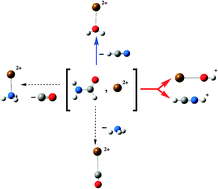Modeling the interactions between peptide functions and Sr2+: formamide–Sr2+ reactions in the gas phase†
Abstract
The interactions between

- This article is part of the themed collection: Multiply charged ions (MCIs) in the gas-phase
* Corresponding authors
a
Departamento de Química, Módulo 13, Facultad de Ciencias, Universidad Autónoma de Madrid, Campus de Excelencia UAM-CSIC, Cantoblanco, Madrid, Spain
E-mail:
otila.mo@uam.es
b
Université d'Evry Val d'Essonne, Laboratoire Analyse et Modélisation pour la Biologie et l'Environnement (LAMBE), Bâtiment Maupertuis, Boulevard François Mitterrand, 91025 Evry, France
E-mail:
Jean-Yves.Salpin@chimie.univ-evry.fr
c CNRS, UMR 8587
The interactions between

 Please wait while we load your content...
Something went wrong. Try again?
Please wait while we load your content...
Something went wrong. Try again?
A. Eizaguirre, O. Mó, M. Yáñez and J. Salpin, Phys. Chem. Chem. Phys., 2011, 13, 18409 DOI: 10.1039/C1CP21578G
To request permission to reproduce material from this article, please go to the Copyright Clearance Center request page.
If you are an author contributing to an RSC publication, you do not need to request permission provided correct acknowledgement is given.
If you are the author of this article, you do not need to request permission to reproduce figures and diagrams provided correct acknowledgement is given. If you want to reproduce the whole article in a third-party publication (excluding your thesis/dissertation for which permission is not required) please go to the Copyright Clearance Center request page.
Read more about how to correctly acknowledge RSC content.
 Fetching data from CrossRef.
Fetching data from CrossRef.
This may take some time to load.
Loading related content
